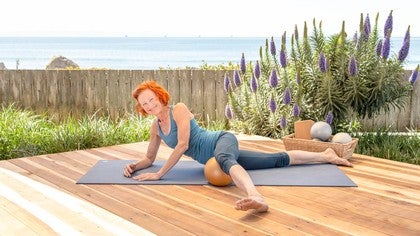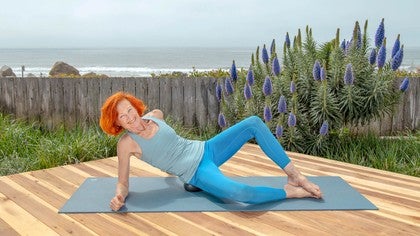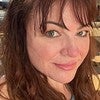Description
Props Needed: Gold Yamuna USA® Ball or 10" Ball
About This Video
Transcript
Read Full Transcript
In this class, we're going to be addressing the adductors. There are actually five different muscles that make up the adductors, but we will be working with them in a global sort of a way. Problems with the adductors. They can become too tight and pull our knees inwards so that they're short, they can also atrophy and very often they're under-worked and they will pull the sit bones, which is in the back of the pelvis, in towards each other, which again, creates this collapsing down of the skeleton, which is part of what you see in the aging process for most people, where less and less of the body is supporting optimal movement. We of course, are going in the reverse direction and we're looking to get younger and bring back many of the elements that may have fallen into disuse or dysfunction.
I like to call this anti-aging or like in the computer where, when we get a upgrade, I think that's what it's called. When you improve the program and you delete aspects that are not working, and we're basically doing that, we're upgrading the quality of our body. The place at the adductors attaches in the front of the pubic bone and they go all the way down to the, your sit bone. So it's literally all the way through this band here. It's where that these muscles attache to the bone.
And then they run down and have fibers that attach down towards the side of the knee and below it. Let's find out what's going on with our adductors. Before we actually start with the balls, I'd like to make an important assessment that each of you will have to do, which is how loose are you in your hips? Some people flop to the floor, some people are up here, some people like me, have an open hip and a much tighter hip. So I need to position my relationship to my adductor differently for the left side and the right side.
So with that in mind, the more tight your hip is, the bigger the ball that you will want to work with so that you can get into the adductor meet your body where it is. So I am now starting with the ball hiked up right between my pubic bone and my inner thigh. It's kind of like a triangle corner. Very important to get the line of the knee to the pelvis at a 90 degree angle. And if you can, with the foot, I have this propensity on this side for my knee to roll inwards, it's an internal rotation.
So I am now propping that side to not allow my body to overindulge in this. The other thing I'm checking is that my lower back is not archy. This is a pattern that often will happen to ease up the focus into the adductors. And we of course want the focus on the adductors. So it is important to position the body to not overindulge in a arch position.
At this point, I have nice pressure into the adductors to the point where now it feels more correct to start to ease my body into them without the additional balls. The focus is completely here. If I was manipulating somebody else's body, I would be pressing down in this area to get full pressure into the adductor, right where it's connecting in with the pubic bone. The other thing to look for is to roll from the pubic bone area all the way to the sit bone. So you're really gliding over that front and back plane of your body to get the tissue of the adductor range of group, the group of muscles to fully get communicated with.
You will probably find where the fibers are more tight for you. (wind whooshing) The other thing you can explore is, if you're looser, the aspiration is that both hips are at the same height. With my case, I'm too tight to be fully up. If you're more of a froggy type, you may find that hiking one hip up gives you more pressure into this area. And that's what you're looking for.
In a sense, we're looking for the adductors to release so much that they can go right out to the side. Once you have a nice sense of pressure, I'm going to move very slightly away from the pubic bone area. So the ball is moved down. I've hiked up this hip in my body, 'cause that feels like it's ready to receive that work, and then start releasing this knee out and in. Notice that as the leg starts to go out, funny things can happen in the knee.
So you don't want to like take it out and let the knee roll in. It defeats the purpose of releasing and working into the tissue. See if you can get it. I'm gonna hike the knee and get, now I'm getting that full release in the adductor, including the IT band. Adductors and IT band have a nice relationship to each other.
And I can feel the muscles starting to lengthen. Oh, I just got another nice release. I'm taking the ball out and rolling a little bit further out to the side. So the ball is now halfway down. I'm just gonna adjust back on my mat and check to see again.
You may find that you can get your hip even more straight as the muscles go deeper. And this bone starts to traction out because they're not gripping so much into the joint. Allow more of the muscle to get pressed in and lengthened. Take your time, work the knee out in the end, I'm starting to feel a nice connection right into the socket as I do this, different for each one of us. The goal isn't to lengthen leg straight.
The goal is to start to lengthen the fibers. Check your kneecap, keep it a constant, going straight forward. Really, really important. Then roll a little bit further out. So now I'm almost at my knee.
This is the area of where the fibers can become very, very tight and dry because knee joints move a lot. So check again the movement of the leg. (wind whooshing) I hope you're finding some nice communication going on with your own structure. And then also roll the knee a little bit up and down. So we're cross-fibering across the where the adductors become thinner and are coming in to support the side of the knee and moving through that area.
This feels so good. Very dry, but it's loosening up and softening up feels so nice. Just gonna check. Now I can sink even deeper into this whole shaft of muscle because it's become more elastic. And last part taking the ball right out just before the knee, I'm going to hike up the other hip because it feels good by now.
And again, moving the knee up and down. In a sense we're doing the same thing we did with the IT band. We moving the quad and the hamstrings away from the adductors, 'cause again, they can get all glued together, they can get stuck, they can become like a group of three or four muscles working as one muscle. And yet the differentiation will give such a better quality of movement and comfort and diminish pain. Oh, I just got another nice release.
My pelvis just got wider and straighter, so good. One more time, nice and out. See if you can bring the hips even more square towards the ground and then come off. Oh, I'm just gonna lie out here for a minute because it feels so good. My leg feels much longer, more open, the whole front of my hip flexor area is like released.
So there was a lot of tightness in the hip flexor that was connected in there. Let's go on and do the other side. Moving to the other side, I am going to use a smaller ball because my hip is more open to begin with and I will be able to get deeper into my adductor at that point. Some people even work with the black ball because the hips are quite open. So use a ball, play around, and use the ball that will give you the most juice for your money.
So starting out, I'm finding the pubic bone area and the top of my inner thigh, positioning the knee so it's exactly going to the side, making sure I'm getting a sense of sinking into the ball, and actually hiking up a little bit. I'm gonna take another ball to hike the hip so I can throw the pressure into the adductor. Allowing the ball to move a little bit down and a little bit up. There's one chord for me, that's really, really tight. And I want to find a way to get it to start to release and lengthen from the pubic bone area out in the direction of the knee.
So I was looking to create this lengthening out, kicking into the adductors. At times, I'd use my breath to help deepen this. I'm going to take a deep breath in, (inhales) feel the pressure into the adductor, and then literally bring my body down to sink in. I'm also taking the pelvis and lengthening it. So the pressure is even more focused into this adductor.
So play around with these things. And here we go with this lengthening of the leg out and in. Totally can feel the relationship of this outer thigh and adductor area. There is a sensation I'm experiencing of those muscles coming in to support the femur. And it feels really correct.
Our muscles are such an act of genius. In fact, they hold human bodies incredibly, designed to support movement, very powerful movement. And it's such a nice thing to discover this. Rolling out a little bit further, so I'm moving the ball, maybe a third of the way down the shaft, checking that my lower back is not collapsing down. In fact, you can take a ball and hike it under your lower back area or yoga block or pillow to support the correct anatomy.
So again, we get the right pressure in the right place to create a release. Again, moving the leg out and in, in my case, I can feel the release all the way from underneath the sit bone and the adductor moving the leg out. Lovely, lovely feeling of traction and release. Also moving the knee a little bit up and down, making sure my knee is not rolled in. That's my pattern.
You have to work with your own pattern to get those muscles to change. And I'm going to take this ball out the little black ball out, moving further out. So now two thirds of the way I'm just gonna readjust on the mat. So two thirds of the way down, starting to get a sense, can I actually have my hips really square so the focus is very strongly on that adductor? Moving up and down, making sure that the lower back is not doing a fake stretch.
I'll put another support here to give me, allow me not to work so hard. Then lengthening out and in. (wind whooshing) Very, very lovely stretched when done right, and can be a game changer for all sorts of movements. And moving a little further out. So you're getting close to your knee.
Square the hips as much as you can and start moving the leg out and in. By the way, if you're a teacher or practitioner of some kind or another, it's lovely to evaluate your own movement pattern, roll out the area that's tight and retrain with a more optimized physiology. Clients love it because there's such a jump in their ability to connect to their body and do something that may have been efforty and hard and straining like. And then roll the knee up and down see if you can get right up close to the end of the shaft just before the kneecap can be really tight and dry. Feels like a lovely deep massage.
Again, back and forth. Lots of movement. Now coming into this whole side of the leg, dancers love this work because it gets them really turned out and open and they can do all the dance movements that they need with so much freedom. And then come on off. Just for a minute lie on your stomach.
Oh, so much open in my hip flexors right now. It's ridiculous. This feels delicious. Also the movement of the legs back and forth, which can be very grippy. Everything is open and flowing.
So I hope you're having this kind of feeling as well. Lovely release into the whole pelvic area. I know we didn't test at the beginning, but actually we did. We did this test. Do you find your knees dropping wider apart?
And if you sit cross-legged and your knees are up, are they a little bit looser, more mobility in the hips because this area is not pulling? And now let's come up to standing and do our final test. Before you go up, check your hinges. How are your knees feeling? How are your feeling?
How are your feet feeling? Bring yourself up to a standing position. Imagine sitting, standing up. Is there more openness? Is there more length?
Take a little walk to see what your legs feel like. I hope you're feeling looser. Something magical has happened. There's more freedom in your pelvis, all around. Notice how you feel the rest of the day.
Notice how you feel tomorrow. Please do share your comments and your questions at the bottom of this video and hope to see you in the next one.
Release Your Fascia: with Niedra Gabriel
Comments
You need to be a subscriber to post a comment.
Please Log In or Create an Account to start your free trial.
















